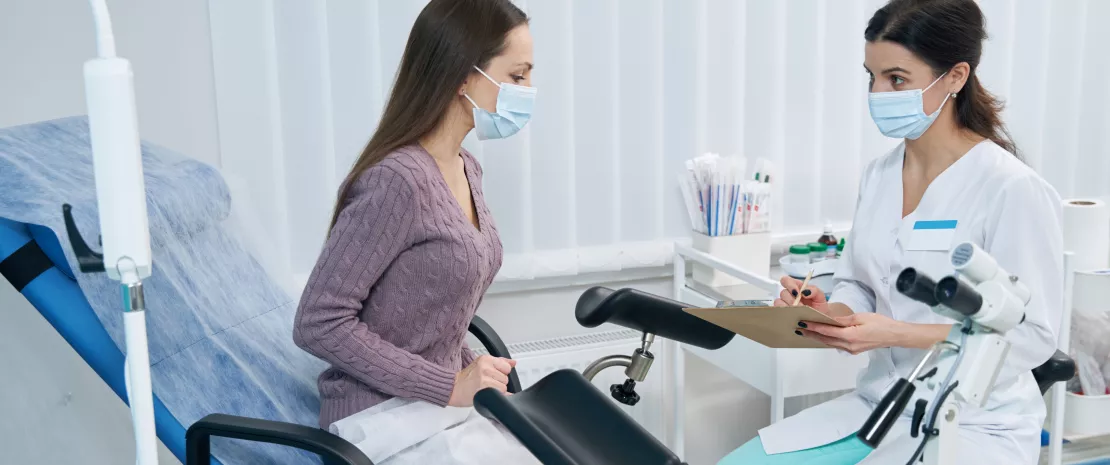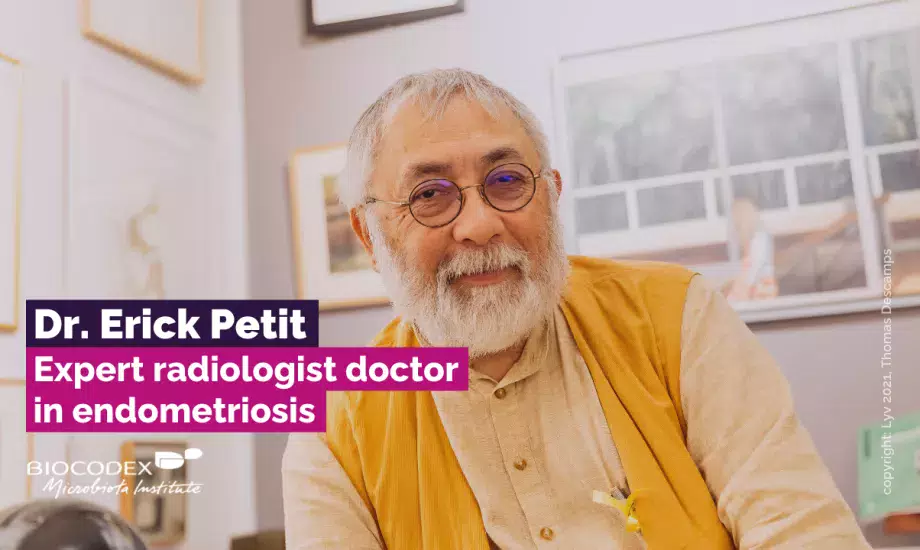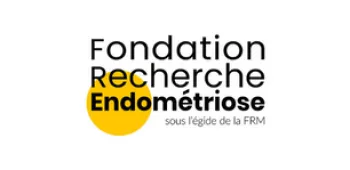Endometriosis and Microbiota: what are the links ?
Symptoms, diagnosis, treatment, potential links to the microbiota... To mark Endometriosis Awareness Month, the Microbiota Institute is handing the floor to three experts. This article deciphers a long-neglected chronic inflammatory disease that is still poorly diagnosed.
Sources
This article is based on scientific information

About this article
Table of contents
Table of contents
“The diagnosis of endometriosis starts by talking to the patient”
Dr. Erick Petit

(sidenote: Dr. Erick Petit, radiologist, founding head of the Endometriosis Center at the Paris St. Joseph Hospital, President of RESENDO (community-hospital endometriosis network), member of the steering committee of the specialist endometriosis group EndoSud-IDF and of the endometriosis national strategy steering committee, co-author of: Tout sur l’endométriose, soulager la douleur, soigner la maladie (Editions Odile Jacob, 2019) [Everything there is to know about endometriosis, easing the pain, treating the illness]. )
Do we know when endometriosis dates back to?
Erick Petit : Endometriosis has a long and sinuous—if not tumultuous—history. Even though the symptoms have been described for 4,000 years, it was not until the end of the 19th century that it was recognized as an organic disease. Unbelievably, that means it was left undiagnosed for almost 4,000 years. The first clinical description of endometriosis dates back to 1855 BC, concerning an Egyptian woman. The disease was next listed in the Greek body of clinical literature around the year 500 BC.
That was when the symptoms were clearly catalogued and the association was made with menstruation. The disease was subsequently considered to be a condition of the feminine psyche and was consigned to limbo until the Renaissance. Hysterikos being Greek for “uterus,” the physicians of the time had a field day with this so-called illness that they believed had been entirely made up by what they referred to as “hysterical” women. The pain, however, was very real...
For centuries, women were imprisoned in the belief that pain was inevitable. They were committed to specially created institutions and marginalized. It was only in the 19th century, thanks to the work of Carl von Rokitansky, a Bohemian pathologist working in Vienna, that endometriosis was histologically confirmed for the first time in 1860.1
Why is the diagnosis of endometriosis so long and complicated?
E. P. : The gold standard test is still the endovaginal ultrasound (or an MRI for young girls who have never had sexual intercourse, although this technique is less sensitive and less specific), but I remain convinced that medical imaging does not tell us the whole story. The scans must be compared with the clinical data and the patient should be listened to carefully. That is why, in the (sidenote: https://www.resendo.fr/ ) network, we use a clinical questionnaire that contains specific questions and gives a better picture of the pain experienced. In nine out of ten cases, the diagnosis of endometriosis is confirmed. We believe that, first and foremost, listening to the patient and having a real conversation is the basis of the diagnosis. Time constraints mean that nobody can spend even 15 minutes talking with a patient anymore.
Yet asking patients the right questions is exactly how we can establish a reliable diagnosis and treat women who have in some cases been left undiagnosed for a whole decade!2 Not enough large-scale epidemiological studies have been conducted to date, but there are tangible signs suggesting that prevalence has been on the rise over recent years. It is commonly said that one in ten women suffers from endometriosis. It is in fact more likely to be one in seven, or even one in five, women of reproductive age.2
1 out of 10 It is commonly said that one in ten women suffers from endometriosis
10 years Some women are in diagnostic wandering for many years, sometimes more than 10 years.
#1 Endometriosis is the leading cause of hyperfertility
Does a typical profile exist for women affected by endometriosis? What are the consequences?
E. P. : It is a complex pathology involving many factors. So there is no typical profile. I would say that there are as many forms as there are patients. There is no correlation between the anatomical and clinical findings for this disease. Certain women can have very severe endometriosis anatomically speaking, without experiencing too much pain. Conversely, others with only mild endometriosis may suffer from debilitating symptoms. This illness is the number one cause of hypofertility,2 which is the second biggest consequence of endometriosis after pain. We have in fact observed a correlation between the extent of the lesions and fertility. But this is not necessarily linked to pain.
What are the early signs?
E. P. : The disease appears at menarche. This is why a young girl should be carefully observed at this time. Is the level of pain intense? Does she remain bedridden during menses? Non-attendance at school is also a good indication. Early menarche (before the age of 11) and having a mother or sister who also suffers from endometriosis are risk factors. To avoid leaving the condition undiagnosed and starting treatment too late, I have been campaigning for years to raise awareness about endometriosis among girls between the ages of 11 and 13 during their medical appointments.
In addition, almost 100% of patients suffering from endometriosis are also affected by some form of irritable bowel syndrome. These symptoms in the digestive system can also be a warning sign of the disease, and they are sometimes the only sign. It is therefore crucial to make gastroenterologists more aware of the condition.
How is it treated?
E. P. : The available care is still very inadequate and is mainly based on hormone treatments. The condition requires multidisciplinary care:
Hormonal treatment will stop menses, thereby preventing pain and halting the progression of the disease.
For more severe forms, surgery may be beneficial in order to remove the endometriosis lesions (this concerns around 1/3 of patients).
Prescription drugs, and also recourse to alternative medicine, which has proved very effective: hypnosis, osteopathy, acupuncture, electrical nerve stimulation, etc.
Nutritional therapy also helps to reduce pain and to significantly improve the continuous functional bowel disorders: this is an essential component.

Gynecology
“Certain clinical signs support the hypothesis of a link between the microbiota and endometriosis”
Vanessa Gouyot

(sidenote: Vanessa Gouyot: dietician with 20 years’ experience, micronutrition specialist for nutritional therapy treating endometriosis within the RESENDO community-hospital network. I have extensive experience working in hospitals since 2003 and I have participated in different research projects. I now run a private practice in Levallois-Perret and at the Landy clinic in the town of Saint-Ouen-sur-Seine. I qualified as a biochemist at Université Paris XII and a specialist in micronutrition at the Faculty of Medicine in Dijon. I am also a media expert in nutrition and have made contributions to two books about endometriosis with RESENDO. )
What links between endometriosis and the microbiota do we know of?
Vanessa Gouyot : Although they are increasingly tangible, these links have not yet been confirmed. To date, no scientific study has been able to formally identify the links between endometriosis and the dysbiosis observed within the various microbiota in the human body.3 However, medical practice has highlighted clinical signs4 that support the hypothesis. We therefore now know, from a dietary perspective, that 90% of women affected by endometriosis also suffer from associated digestive disorders (irritable bowel syndrome or poor digestion in particular). At my practice, I see a great many patients who state that they have an imbalanced microbiota, whether it concerns their oral, gastric and/or gut microbiota. One hypothesis seems to be emerging: endometriosis is an inflammatory disease that could be feeding on the “fertile” inflammatory environment in the digestive tract (i.e., the low-grade inflammation in the gut) in order to develop.
90% of women affected by endometriosis also experience associated digestive disorders”
43% Of women know that the intestinal microbiota influences the vaginal microbiota.
Could the microbiota nevertheless accelerate the diagnosis of the illness?
V. G. : Endometriosis is a chronic inflammatory disease that is complex and often diagnosed late. The pathophysiology of endometriosis has inspired numerous hypotheses but it has not yet been possible to determine which is the most robust. The gut microbiota is a promising line of investigation that is offering new perspectives for research to enhance our understanding of what causes this pathology.5 Eventually, what we might consider is not necessarily an assessment of endometriosis via the microbiota, but instead improved diagnosis of digestive inflammation6,7 through the assessment of the microbiota.
Endometriosis can only be diagnosed by taking a holistic approach. Today when treating a new patient suffering from endometriosis, we review her whole lifestyle, i.e., her diet, including liquid intake, the quality of the air in her living environment, etc. We even go right back to birth, because we know that the first months of life are pivotal to the formation of the microbiota. When I take their history, I also question my patients about any digestive system disorders existing prior to menarche. Nearly 90% of my patients who suffer from endometriosis were also affected by disorders of the digestive system before menarche, although the statistic should be analyzed objectively.
My mission is to enable my patients to understand that the digestive tract is a passage which is permanently under assault. This aggression may alter the digestive system and lead to inflammation. This holistic approach should be accompanied by a multidisciplinary component including family doctors, gynecologists, pain specialists and osteopaths, etc. Every effort should be made to avoid leaving patients undiagnosed. I am convinced that a coordinated and multidisciplinary care pathway is the key to early diagnosis and improved treatment for patients with endometriosis.
Vanessa Gouyot :
“The pathophysiology of endometriosis has inspired numerous hypotheses but it has not yet been possible to determine which is the most robust. The role of the microbiota is one hypothesis among many.”
Could the microbiota eventually be used in the search for future treatments?
V. G. : Research into the microbiota8,9is making rapid advances. It is a source of much hope and should, in the medium term, reduce the time to diagnosis for endometriosis patients suffering from disorders of the digestive system. Probiotics currently represent one of the solutions that can be offered to restore the gut flora and reduce inflammation. The problem is the knowledge deficit regarding their use.
It should be pointed out that taking probiotics alone is not a cure for intestinal hyperpermeability. It can help, but it does not restore the condition of the gut. Certain patients judge that they do not need them, others take them but not regularly, and others have abandoned their course of priobiotics because they felt that the treatment had no effect. Time must be set aside to explain, reassure, and also adjust treatment according to needs. The objective of probiotic therapy is to give our patients the tools to manage their condition, so that they become more attentive to signals from their body. Helping our patients live a normal life with less symptomatic pain is the ultimate victory for us.

41% Only 41% of women surveyed say they have taken probiotics and/or prebiotics (either orally or vaginally)
Infographic: What are probiotics?
“Diet plays a major role in relieving a painful digestive system associated with endometriosis”
Dr Laetitia Viaud Poubeau

(sidenote: Dr. Laetitia Viaud Poubeau : Doctor of medicine, specialized in functional medicine and nutrition. She graduated with a specialist doctorate degree in general medicine and added to her qualifications through various training courses in micronutrition. Finding the link between the impact that the condition of the microbiota can have on what are referred to as diseases of civilization has become her passion. All her acquired expertise has enabled her to address the needs of her patients more effectively. )
In the case of endometriosis, can nutrition play a role in restoring balance to the microbiota?
Laetitia Viaud Poubeau : An anti-inflammatory diet, such as a Mediterranean diet for example, can only be beneficial to the gut microbiota for those suffering from endometriosis.
This type of diet is rich in vegetables, fruits, pulses and whole grains, but also in Omega-3 fatty acids, which are both prebiotics and anti-inflammatory, and it encourages the development of a flora that is eubiotic, rich in bifidobacteria and lactobacilli.10-12
Such nutrition optimizes the synthesis of short-chain fatty acids, such as butyrate, which fuels the microbiota and the cells in the gut.13,14
There are three benefits: it promotes a balanced gut microbiota, combats intestinal permeability and thereby reduces the underlying low-grade inflammation.
What foods should be excluded from the diets of endometriosis patients?
L. V.-P. : The “Western diet,”11,15 which is rich in processed foodstuffs, refined sugar, salt, saturated fats (red meat for example) and trans fat (such as pastries),16 is detrimental to the balance of microbes in the gut. This type of diet causes gut dysbiosis and low-grade inflammation. Drinks like sodas, fruit syrups, fruit juice and strong alcoholic beverages should also be avoided.
Studies have also demonstrated the benefits of reducing the intake of gluten11,17,18 which, by activating
(sidenote:
Zonulin
Protein involved in the regulation of epithelial and endothelial permeability.
It is secreted by the liver, among other organ tissues, and at the surface of enterocytes in the intestinal mucosa, acting on the tight junctions.
Fasano A. Intestinal permeability and its regulation by zonulin: diagnostic and therapeutic implications. Clin Gastroenterol Hepatol. 2012 Oct;10(10):1096-100.
)
, opens tight junctions and increases systemic inflammation.
On the other hand, the consumption of dairy products does not seem to put individuals at a higher risk of developing endometriosis.19,20 The levels of growth hormones that they contain may, however, be conducive to the relative hyperestrogenism of patients suffering from endometriosis.21 Additionally, hypersensitivity to milk proteins maintains low-grade inflammation.11
Attention should also be paid to the impact of additives, endocrine disruptors, antibiotics used in the agri-food industry, pesticides and other chemical pollutants. Many of these are found in our foods and affect the balance of our microbiota.
Foods to be avoided by endometriosis patients:
- processed foodstuffs
- refined sugar
- salt
- saturated fat (red meat, etc.)
- trans fat (pastries, etc.)
- sodas, syrups, fruit juice
- strong alcoholic beverages
- reduce gluten intake
What are the consequences of a Western-style diet on the gut microbiota? Is this diet responsible for the gastrointestinal disorders observed in endometriosis?
L. V.-P. : Gut dysbiosis caused by a Western diet is conducive to the development of gram-negative bacilli. These bacteria have a lipopolysaccharide (LPS) molecular pattern that causes metabolic endotoxemia and triggers low-grade inflammation via the activation of the TLR4 receptor.11,22,23
This induced dysbiosis results in discomfort in the gut, which can range from constipation to diarrhea. We have also observed bloating, intestinal spasms and flatulence that can be odorous to varying degrees, which all add to the discomfort of patients suffering from endometriosis.
In this case, a diet excluding FODMAPs (Fermentable Oligo- Di- Monosaccharides and Polyols) or a digestive-sparing diet can be introduced during the initial phase of balancing patients’ dietary habits in order to provide rapid relief.24 The digestive-sparing diet is a model that aims to reduce inflammation and help the gut mucosa to heal. It is based on a set of simple dietary and lifestyle rules: excluding raw vegetables and raw fruits; limiting citrus fruits and cruciferous vegetables; cutting out lactose, gluten, and irritant beverages like coffee, strong alcohol and sodas. It can be followed for 4 to 6 weeks, is less restrictive than the FODMAP-free diet and above all does not alter the gut flora balance like the FODMAP-free diet does, which reduces the endoluminal concentration of bifidobacteria.25
Gastroenterology
In France, throughout the month of March, the Microbiota Institute and the Foundation for Endometriosis Research are mobilizing to raise awareness among the general public and health professionals about the possible links between the microbiota and endometriosis. The Foundation for Endometriosis Research under the aegis of the FRM supports research projects on endometriosis. By making a donation to the Foundation for Research on Endometriosis, you contribute to the opening of new research projects necessary to better understand the disease and potentially the links with the microbiota.
They support this article:
Recommended by our community

"🥺 I’ve been struggling with this for almost 12 years & to finally see some awareness being raised really settles my heart ❤️" - Sharaya💋
"Thank you 4 sharing. Interesting point of view." - Ian
"Very good project" - Serega
(From Biocodex Microbiota Institute on X)
BMI 22.07
2. Kvaskoff M. Epidémiologie de l’endométriose. In : Petit E, Lhuillery D, Loriau J, Sauvanet E. Endométriose : Diagnostic et prise en charge. Issy-les-Moulineaux : Elsevier Masson ; 2020. P.9-14.
11. Panizza D. L’intestin et le poids. De la dysbiose au surpoids, de l’inflammation à l’obésité. Muret: Edition Géo Reflet; 2017.















